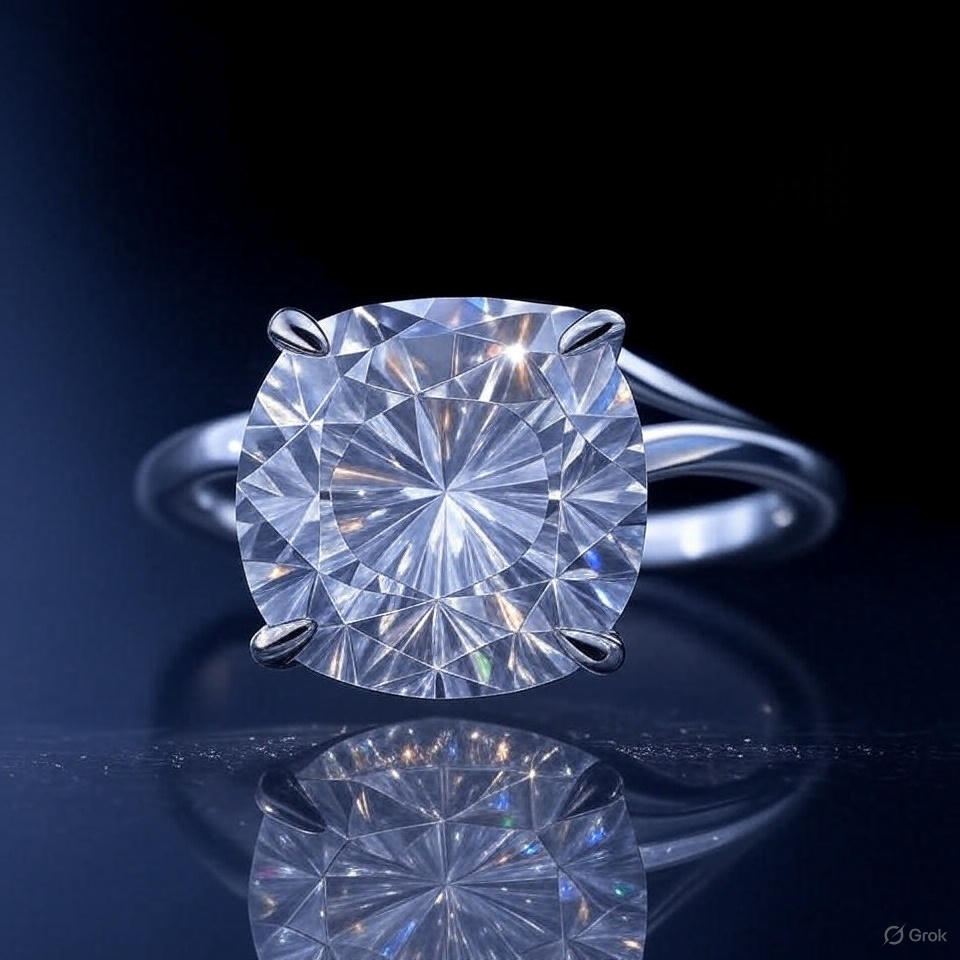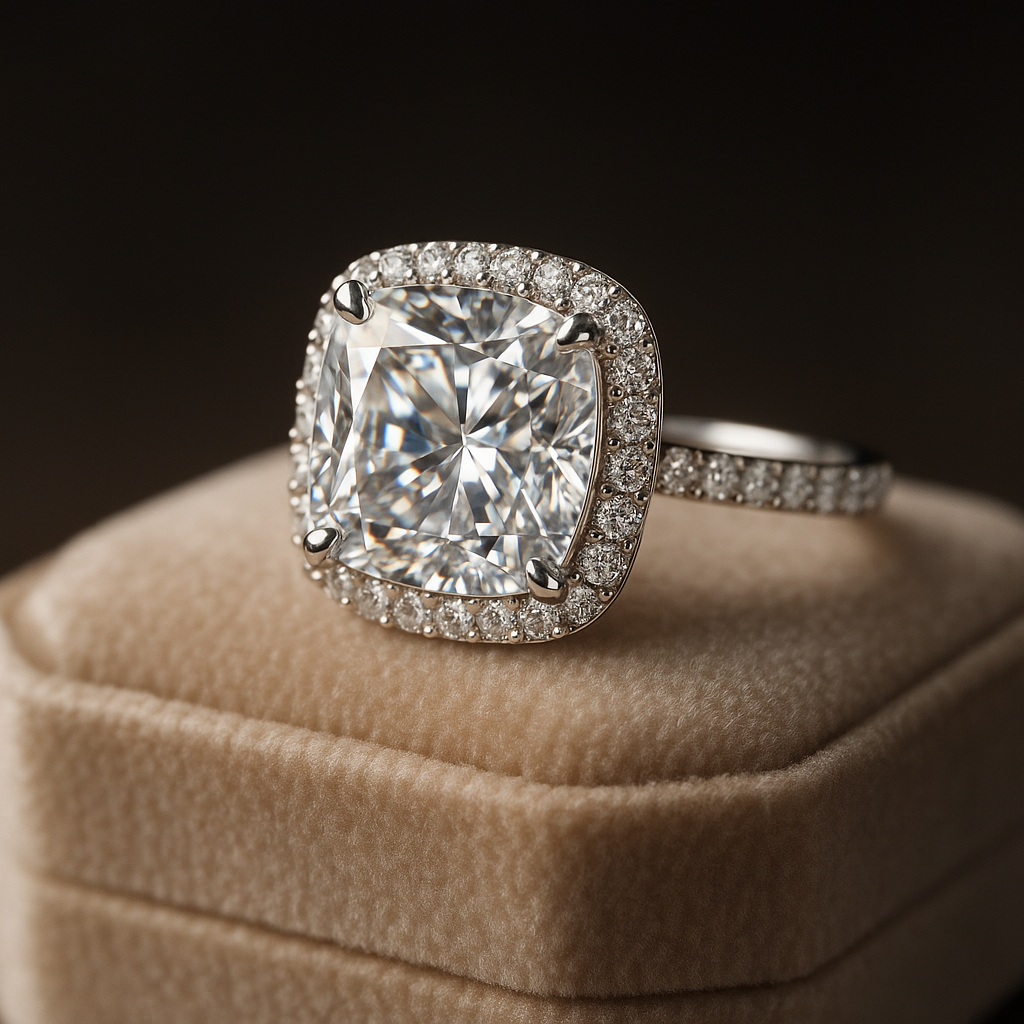Cushion Diamonds: The Complete Guide to Romance, Vintage Charm & Modern Sparkle
🌟 Introduction: Why Cushion Diamonds Capture Hearts

Softly rounded, romantic, and endlessly versatile — cushion cut diamonds combine vintage elegance with modern sparkle. Known for their pillow-like shape (hence the name), cushion diamonds have been beloved for more than 200 years. Once the most popular cut of the 19th century, they are now experiencing a renaissance thanks to their unique blend of antique charm and contemporary brilliance.
From vintage-style halos to minimalist solitaires, cushion diamonds bring warmth and personality that appeals to both traditional romantics and modern trendsetters. They’re also a favorite among celebrities: from Kim Kardashian’s 15-carat cushion engagement ring to Priyanka Chopra’s elegant cushion diamond, this cut has re-emerged as one of the most desirable choices.
In this guide, we’ll explore everything about cushion diamonds — their history, unique features, the 4Cs, buying tips, myths, FAQs, and why they remain the perfect fusion of past and present.
📜 A Romantic History of Cushion Diamonds
🔹 The Old Mine Cut: A Cushion Ancestor
The story of the cushion diamond begins in the 18th century with the Old Mine Cut. These early diamonds, cut by hand, had a squarish shape with rounded corners and a deep pavilion. They were designed to sparkle under candlelight, giving them a soft, romantic glow.
🔹 The Classic Cushion
By the 19th century, the Old Mine evolved into what we now call the Cushion Cut. It retained the rounded corners and square outline but featured more facets, improving brilliance while maintaining its vintage charm.
🔹 The Modern Cushion Brilliant
In the 20th century, technology allowed for more precise cutting. Jewelers developed the Cushion Brilliant, a hybrid of the vintage cushion and the modern round brilliant, with extra facets for maximum sparkle. Today, cushion diamonds come in many variations — from chunky vintage-style facets to modern crushed-ice looks — offering buyers a wide range of aesthetics.
💡 Real-World Example: The famed Hope Diamond, one of the world’s most famous gems, is a cushion cut.
💡 What Makes Cushion Diamonds Unique?
Cushion diamonds stand out because they bridge the gap between old-world romance and modern brilliance.
- Soft Shape: Square or rectangular outline with rounded corners.
- Versatility: Available in vintage-style chunky cuts or modern brilliant versions.
- Romantic Sparkle: Not as fiery as a round, but more character and depth.
- Variety of Looks: From antique cushion modified brilliants to “crushed ice” styles.
- Warm Glow: Cushions often emphasize fire (colored light) over brilliance (white sparkle).
📊 Fun Fact: In the 1800s, cushion cuts were the most popular diamond shape — the “round diamond” of their era.
🔍 The 4Cs of Cushion Diamonds
Cushion cuts interact with the 4Cs differently than other shapes. Here’s what to know:
1. ✂️ Cut: Style & Sparkle Variations
Unlike rounds, cushions don’t have a standardized “ideal cut.” Instead, they come in different cutting styles:
- Cushion Brilliant: Larger facets, more fire, vintage feel.
- Cushion Modified Brilliant: Extra facets, more sparkle, sometimes “crushed ice” appearance.
- Antique Cushion: Chunky facets, old-world charm.
Length-to-Width Ratios:
- Square cushions → 1.0–1.05 ratio.
- Rectangular cushions → 1.10–1.25 ratio.
💡 Tip: Always view cushion diamonds in person or through 360° video. Their looks vary dramatically.
2. 🎨 Color: Cushions Show More Warmth
Cushions tend to hold color more strongly than rounds.
- For a white look in platinum/white gold, aim for F–H color.
- For yellow/rose gold, you can go warmer (I–J).
- Cushions are popular in fancy colors (yellow, pink, blue) because they emphasize saturation beautifully.
3. 🔍 Clarity: Facets Help Hide Flaws
Cushions hide inclusions fairly well due to their facet patterns.
- VS2 or SI1 clarity often looks eye-clean.
- Avoid inclusions in the table (center), where they’re most visible.
- Vintage chunky cushions can reveal inclusions more easily than crushed-ice types.
4. 💎 Carat: Cushions Look Smaller Face-Up
Because cushions are deeper-cut, they appear smaller face-up than rounds or ovals of the same carat weight.
- A 1.0ct cushion often looks closer in size to a 0.85ct round.
- To maximize size, consider rectangular cushions, which spread more length across the finger.
💡 Example: A buyer chose a 1.5ct cushion instead of a 1.2ct round for nearly the same price, getting a bigger-looking stone for her budget.
💍 Cushion Diamonds in Engagement Rings

Cushion diamonds shine in both vintage-inspired and modern minimalist settings.
Popular Settings:
- Halo Setting: Accentuates cushion shape and adds sparkle.
- Solitaire: Highlights the diamond’s soft outline.
- Double Halo: Extra glam and size boost.
- Vintage-Inspired Settings: Cushions pair perfectly with milgrain or filigree details.
Celebrity Inspiration:
- Kim Kardashian → 15-carat cushion engagement ring from Kanye West.
- Priyanka Chopra → Elegant cushion solitaire.
- Sofia Vergara → Cushion diamond with halo.
Looking for a top grade diamond retailer? Read our detailed Blue Nile Review.
🏆 Advantages of Cushion Diamonds
- Romantic, vintage charm → perfect for antique-inspired rings.
- Versatility → square or rectangular options.
- Fire over brilliance → emphasizes rainbow flashes.
- Great with fancy colors → enhances colored diamonds beautifully.
- Lower price → often 20–30% cheaper than rounds.
⚖️ Cushion Diamonds vs. Other Shapes
| Feature | Cushion Diamond | Round Diamond | Oval Diamond | Emerald Diamond |
|---|---|---|---|---|
| Brilliance | ⭐⭐⭐⭐ | ⭐⭐⭐⭐⭐ | ⭐⭐⭐⭐ | ⭐⭐ |
| Fire (rainbow light) | ⭐⭐⭐⭐⭐ | ⭐⭐⭐⭐ | ⭐⭐⭐ | ⭐⭐ |
| Vintage Appeal | ⭐⭐⭐⭐⭐ | ⭐⭐⭐ | ⭐⭐ | ⭐⭐⭐⭐ |
| Face-Up Size | ⭐⭐⭐ | ⭐⭐⭐⭐ | ⭐⭐⭐⭐⭐ | ⭐⭐⭐ |
| Price Premium | Low | High | Medium | Medium |
💰 Pricing & Value
Cushion diamonds are usually 20–30% less expensive than round brilliants of the same weight and quality, making them a budget-friendly yet elegant choice.
Tips to Maximize Value:
- Consider “just under” carat weights (0.90, 1.40).
- Explore cushion modified brilliants for sparkle.
- Lab-grown cushions offer huge savings with identical beauty.
🌍 Ethical & Sustainable Cushion Diamonds
- Lab-Grown Cushions: Affordable and eco-friendly.
- Vintage/Antique Cushions: Sustainable with character.
- Conflict-Free Stones: Certified via Kimberley Process.
🎯 Advanced Tips
- Prongs: Double prongs protect rounded corners.
- Length-to-Width Ratio: Decide square vs rectangular look.
- Lighting Test: Always check cushions in different lighting — sparkle varies widely.
❓ Extended FAQ on Cushion Diamonds
- Are cushion diamonds vintage or modern?
Both. The cushion shape began as hand‑cut Old Mine diamonds with high crowns, small tables, and soft rounded corners; today you’ll also find modern cushion brilliants engineered for extra light return. Think one silhouette, two personalities—antique “chunky” vs. contemporary “sparkly.” - Do cushion diamonds sparkle like rounds?
Not quite. Rounds maximize balanced white light (brilliance) and contrast. Cushions often trade a bit of that for more fire—those rainbow flashes—so the look is romantic and lively rather than laser‑bright. Well‑cut cushions can still be very sparkly; the flavor of sparkle is just different. - Why do cushions look smaller face‑up?
They’re usually cut deeper, so more weight sits below the surface. As a rough idea, a 1.00 ct round often measures ~6.4–6.5 mm; a square cushion of the same weight commonly lands around ~5.9–6.1 mm. Prioritize millimeter measurements over carat when comparing face‑up size. - Are cushions cheaper than rounds?
Typically yes—about 20–30% less for comparable color/clarity because round brilliants command a strong market premium. Exceptional cut quality or branded cushions can narrow that gap. - Do cushion diamonds hide inclusions well?
Often. Crushed‑ice (many small facets) patterns camouflage inclusions better, while chunky antique facets behave like windows and can reveal them. For SI1/SI2 cushions, prefer inclusions off‑center or near a prong. - What’s the best color grade?
For white metals (platinum/white gold), F–H keeps a crisp look. In warm metals (yellow/rose gold), I–J blends beautifully and can feel intentionally warm. Bonus: faint–medium blue fluorescence can make near‑colorless stones appear a touch whiter; just confirm there’s no haziness in strong fluorescence. - Do cushions show color more than rounds?
Yes. Their depth and facet layouts tend to hold body color, which also makes cushions popular for fancy colors (yellows/pinks) where saturation is the goal. If you’re color‑sensitive, step one grade whiter than you’d choose in a round. - What’s the best clarity grade?
VS2 or SI1 is usually “eye‑clean” in cushions, especially under ~2 ct. Go a notch cleaner (VS1) if you’re buying a large stone, a very open “chunky” facet style, or you’re extremely inclusion‑sensitive. - What length‑to‑width ratio is best?
- 1.00–1.05: square, classic cushion outline.
- 1.10–1.25: graceful rectangular elongation that can slim the finger.
Be aware that more elongation can introduce a faint bow‑tie (a darker band across the center) in some stones—view videos or light‑performance images when possible.
- Are cushions good for halos?
Excellent. A halo emphasizes their soft outline and adds finger coverage. Ask for tight fit halos (minimal gap), consider double claw prongs for a refined look, and choose melee size that complements—not overwhelms—the center. - Do cushion diamonds chip easily?
They’re tougher than pointed shapes (no sharp tips), but corners are still the vulnerable spots. Double claw prongs or a delicate bezel boost protection, and avoiding “extremely thin” girdles reduces risk. - Do cushion diamonds hold resale value?
Resale is generally weaker than rounds (which are the most liquid) but stronger than niche fancy shapes. If future flexibility matters, buy from a jeweler with a trade‑in/upgrade policy and focus on top‑tier cut and desirable dimensions. - What’s the difference between cushion brilliant & cushion modified?
- Cushion Brilliant (often “chunky”): Larger, blocky facets; sometimes higher crowns and smaller tables; emphasizes bold flashes and an antique vibe.
- Cushion Modified Brilliant (“crushed‑ice”): Extra facets (especially near the culet) create a fine, glittery mosaic; more scintillation, less pattern definition.
Neither is “better”—it’s a style choice. Because GIA does not grade cut for cushions, judging with your eyes (videos/ideal‑scope/ASET if available) matters.
- Are lab‑grown cushion diamonds real?
Yes. They’re diamond—same crystal structure, hardness, and optics—grown by HPHT or CVD. Labs laser‑inscribe them and issue reports. Just know that pricing and resale dynamics differ from mined diamonds; buy for the look and value you want now. - Are cushion diamonds trendy?
They’ve been around for 200+ years and cycle in and out of the spotlight. Current popularity comes from their vintage roots plus modern sparkle options—so they read timeless, not faddish.
🔮 Myths & Misconceptions
- Myth 1: Cushion diamonds don’t sparkle.
Reality: They sparkle differently — with more fire than brilliance. - Myth 2: All cushions look the same.
Reality: Cushions vary widely (chunky, crushed-ice, brilliant). - Myth 3: Cushion diamonds are outdated.
Reality: They’re classic, with a modern revival in celebrity rings.
📌 Conclusion: Should You Choose a Cushion Diamond?
If you want:
✔ A romantic, vintage-inspired diamond
✔ A unique balance of charm and brilliance
✔ A softer shape than princess, but more character than round
✔ A budget-friendly choice without losing elegance
…then the cushion cut diamond is perfect for you.
With over two centuries of history and modern versatility, cushion diamonds remain a beloved choice for couples who want a diamond that tells both a story of the past and a vision of the future.

